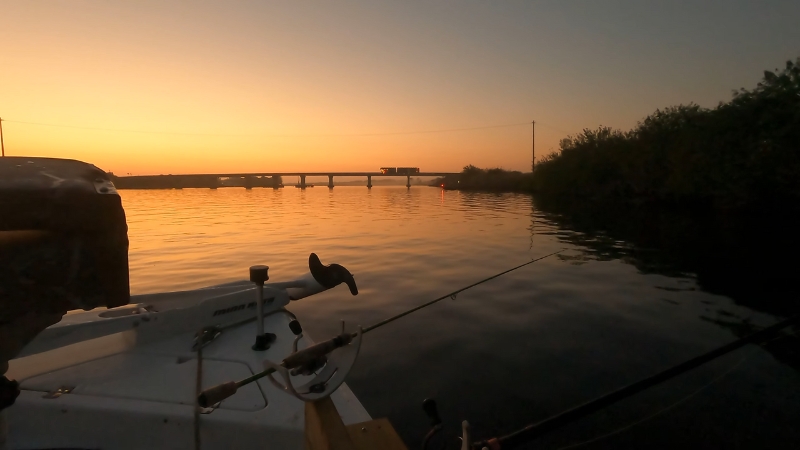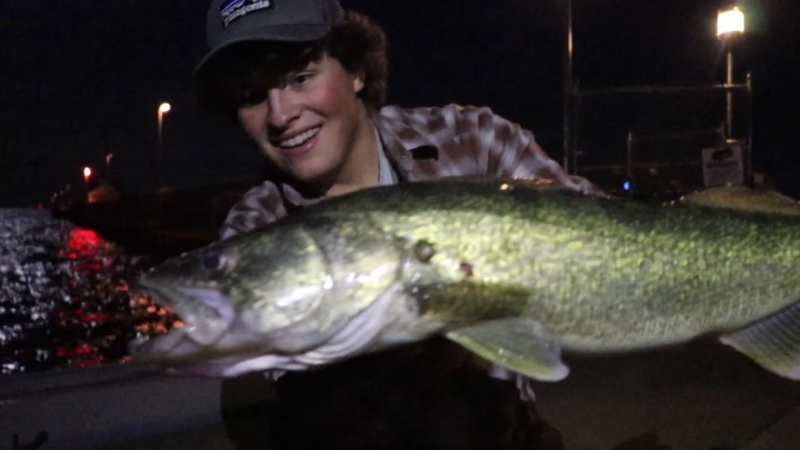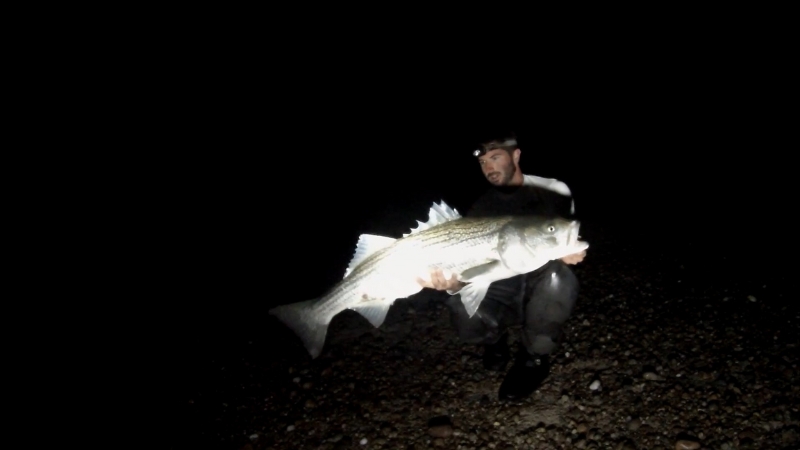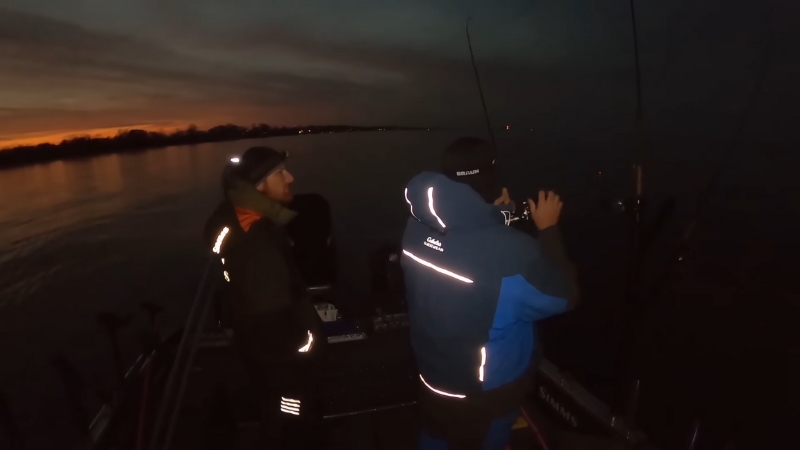Night fishing across the United States has grown far beyond a side hobby. From Texas lakes that glow under soft moonlight to the illuminated bridge spans of Florida’s Keys, anglers across the country now plan entire trips around after-dark action.
Cooler air, quieter waters, and fish that suddenly turn aggressive when the light fades have made the night shift one of the most productive and peaceful times to fish.
Below is a detailed guide to ten of the best places for night fishing in the U.S., complete with species to target, proven tactics, and regional patterns that repeat season after season.
Why Night Fishing Works So Well

Predator fish don’t rely only on sight. Their lateral lines detect vibration and pressure, allowing them to locate prey even in murky or pitch-black water.
When the sun drops, predatory species like bass, walleye, and catfish move shallow to feed more confidently. The reduced visibility gives them the upper hand over smaller fish.
Guides across the country agree on three key points:
- Safety comes first. Every experienced night angler starts with working navigation lights and the required Coast Guard safety gear. Even a small boat must have visible bow and stern lights and backup batteries.
- Go loud and go bold. Bass pros say that at night, fish hunt by vibration and sound. Spinnerbaits with large blades, topwaters that pop or buzz, and crankbaits that wobble heavily all stand out in the dark.
- Heat drives the pattern. When daytime temperatures and boat traffic soar in summer, many lakes fish better at night. Some state agencies even recommend night catfishing or bass trips during July and August for this reason.
1. Lake Fork, Texas
Lake Fork, east of Dallas, is a bass angler’s dream. It consistently ranks among Texas’s top trophy bass waters, with dozens of “ShareLunker” fish over eight pounds each year.
By night, Fork’s big bass move shallow to feed, especially when water temperatures stay high and pressure from daytime anglers fades.
Best Seasons and Patterns
- Late spring through early fall
- Warm, stable nights around a new moon
- Points, timber edges, and channel bends near flats
Go-To Tactics
- Slow-roll large dark spinnerbaits through submerged timber
- Pitch 10-inch plastic worms or creature baits along grass lines
- Walk big topwaters near flooded cover when the wind is calm
Local guides emphasize that Lake Fork’s slot limits are strictly enforced. Check regulations before launching to stay compliant.
2. Kentucky Lake, Kentucky and Tennessee

Kentucky Lake is a vast southern reservoir where night fishing is deeply rooted in local tradition. Many anglers swear by the after-dark bite, especially for smallmouth and catfish.
Key Areas
- Rocky points and ledges for smallmouth
- Creek mouths and channels for largemouth
- Deep humps and river sections for catfish
Night Tactics
- Black spinnerbaits or jigs are dragged along rocky bottoms
- Slow-moving soft plastics on deep ledges
- Cut bait rigs or live bait for catfish near drop-offs
July and August are prime months. Locals say the best bites often start an hour after sunset and last through midnight.
3. Clear Lake, California
View this post on Instagram
Clear Lake, about two hours north of San Francisco, has long been called a bass powerhouse. The same lake also produces some of the biggest channel catfish in the West, especially at night.
Best Zones
- Shallow rock and weed flats near mid-lake
- Soft-sloping flats close to channels for catfish
- Docks and marina lights for crappie
Night Tactics
- Slow spinnerbaits or jigs around shallow cover for bass
- Cut bait rigs on the flats for catfish
- Slip floats with live minnows near lights for crappie
Summer catfish derbies often fill the lake with glowing bobbers and lanterns—a sign of just how productive those hours can be.
4. Lake Okeechobee, Florida

Lake Okeechobee, Florida’s “Big O,” has a long history of producing giant bass. When the midday heat hits triple digits, locals wait for nightfall. After dark, the outside edges of reed beds and grass lines come alive with feeding fish.
Key Patterns
- Focus on outer vegetation edges near deeper water
- Target current seams and cuts where bait moves
- Choose nights with light wind to mask surface glare
Recommended Tactics
- Buzzbaits and prop baits that churn the surface
- Large spinnerbaits or worms pitched into holes in the grass
Several marinas around Clewiston and Okeechobee City offer guided night trips designed specifically for bass.
5. Lake of the Woods, Minnesota
Lake Of The Woods Fishing Report: https://t.co/bSjjSa1pVS pic.twitter.com/8LQJtA4Zdp
— MinnesotaOutdoorsman (@outdoorsmn) January 16, 2024
Spanning the Minnesota–Canada border, Lake of the Woods is often called the “Walleye Capital of the World.” As daylight fades, the walleye bite ignites.
Best areas at night
- River mouths and shallow bars near Rainy River
- Sand and gravel flats beside deep basins
- Wind-blown rocky points
Night tactics
- Troll crankbaits that run just above the bottom
- Drift slip bobbers with leeches or minnows
- Cast jigs tipped with bait over reef tops
Even around big waters like Lake of the Woods, compact night vision monoculars help anglers navigate channels and reef edges safely before moonrise.
Because the lake crosses international borders, always check whether you’re fishing Minnesota, Ontario, or Manitoba waters before heading out.
6. Lake St. Clair, Michigan

Lake St. Clair sits between Lake Erie and Lake Huron, and it lights up with night action each summer. Anglers target walleye and catfish along the channels that slice through the lake.
Prime areas
- North and middle channels where weed edges meet the current
- River mouths on the U.S. side
- Shipping channels dropping from shallow flats
Night tactics
- Cast crankbaits over weeds for walleye
- Bottom rigs with cut bait for channel cats
- Tubes or small swimbaits for smallmouth bass around rocks
The Lake St. Clair Walleye Association notes that July nights often produce some of the largest catches of the season.
7. Cape Cod Canal, Massachusetts

For striped bass anglers, few places carry more weight than the Cape Cod Canal. When large fish move in during late spring, the canal’s fast currents and shadow lines become legendary nighttime territory.
Key Variables
- Current direction and speed dictate everything
- Moon phase influences feeding windows
- Safety is vital along the rocky, fast-moving banks
Night Tactics
- Heavy metal jigs swung through current seams
- Large soft plastics on stout jig heads
- Oversized topwater plugs when bait pushes to the surface
Local veterans recommend focusing on darker nights near the new moon, when the biggest stripers prowl closer to shore.
8. Florida Keys Bridges and Islamorada
View this post on Instagram
At night, the bridges connecting the Florida Keys glow with artificial light that draws in baitfish and massive predators. Islamorada is especially famous for its bridge tarpon bite.
Prime Zones
- Channel 2 and Channel 5 bridges
- Islamorada bridges and nearshore reefs
- Patch reefs within short boat runs
Night Tactics
- Drift live mullet or crabs through light lines for tarpon
- Drop cut bait or shrimp for mangrove snapper
- Bounce jigs with bait along pilings for grouper
Anglers often hear the heavy roll of tarpon before they see them, a sound that can raise goosebumps under the bridge lights.
9. Lake Erie and the Great Lakes

Lake Erie dominates the Great Lakes night fishing scene. The western and central basins are known for outstanding walleye action after dark. Elsewhere, Lakes Michigan and Ontario deliver salmon and trout in the right seasons.
Key Zones
- Western basin reefs and shoals
- Central basin nearshore structures
- Open-water trolling lanes for suspended walleye
Night Tactics
- Troll crankbaits behind planer boards at slow speeds
- Cast from shore into rocky points using glow lures
- Use high-contrast or luminous finishes for visibility
Night tournaments and evening charter trips are common across Erie ports, which tells you everything about how productive those hours can be.
10. Southern Catfish Reservoirs and Lake Cumberland, Kentucky
Night catfishing in the South borders on ritual. Lakes like Cumberland, Wheeler, and Truman fill with anchored boats glowing under lanterns.
State biologists actively recommend night outings during warm months when catfish roam the shallows.
General Patterns
- Move shallower at night as fish leave deep holes
- Focus on wind-blown banks and points
- Look for current, inflows, or rocky structure
Night Tactics
- Medium-heavy rods with strong line
- Cut shad, bluegill, or other legal baitfish on circle hooks
- Anchor above structure or slow-drift over flats
Many anglers run blacklights to illuminate fluorescent line, making subtle bites easier to see.
Universal Night Fishing Safety and Technique Principles

Before heading out after dark, a few universal rules keep night fishing both safe and productive. Every angler should master these basics first.
Safety
- Scout in daylight. Learn the layout, underwater hazards, and safe exits before darkness.
- Check all lights. Navigation and anchor lights must be visible from 360 degrees.
- Bring redundancy. Spare batteries, backup flashlights, and glow sticks save trips.
- Tell someone. File a float plan and carry a charged phone or VHF radio.
- Wear PFDs. Even strong swimmers lose orientation in cold or dark water.
Technique
- Think silhouette. Dark-colored lures create contrast against the sky or surface.
- Add vibration. Spinnerbaits, buzzbaits, and rattling plugs help fish locate the target.
- Slow your retrieve. Fish track sound and pressure; slower retrieves let them commit.
- Use sound clues. Listen for bait flicking or predators feeding to locate active areas.
Quick Comparison Table
| Location | Primary Night Species | Best Season | Typical Tactics |
| Lake Fork, TX | Largemouth bass | Late spring–early fall | Spinnerbaits, worms in timber, topwater near cover |
| Kentucky Lake, KY/TN | Smallmouth, largemouth, catfish | Summer | Black spinnerbaits, jigs, cut bait |
| Clear Lake, CA | Bass, catfish, crappie | Late spring–fall | Spinnerbaits, jigs, cut bait rigs |
| Lake Okeechobee, FL | Largemouth bass | Warm months | Buzzbaits, worms, spinners along grass |
| Lake of the Woods, MN | Walleye, pike, muskie | Open-water season | Crankbaits, slip bobbers, live bait |
| Lake St. Clair, MI | Walleye, catfish, smallmouth | Summer | Crankbaits, cut bait, swimbaits |
| Cape Cod Canal, MA | Striped bass | Late spring–fall | Heavy jigs, big plugs in current |
| Florida Keys / Islamorada | Tarpon, snapper, grouper | Warm months | Live bait under bridge lights |
| Lake Erie / Great Lakes | Walleye, salmon, trout | Spring–fall | Trolling crankbaits, casting glow lures |
| Southern reservoirs / Lake Cumberland | Catfish, hybrid bass | Late spring–early fall | Cut bait on bottom rigs |
Final Thoughts
Night fishing in the United States has matured into its own culture. The mix of cooler air, quiet surroundings, and the thrill of unseen strikes creates something distinct from daytime angling.
It doesn’t matter it’s a bass feeding under Texas moonlight, a walleye biting on a Minnesota reef, or a tarpon rolling under a Florida bridge, the best fishing often starts when most people pack up and head home.
Those who learn to fish safely and confidently in the dark often discover what many lifelong anglers already know: the night belongs to those who stay on the water longest.

